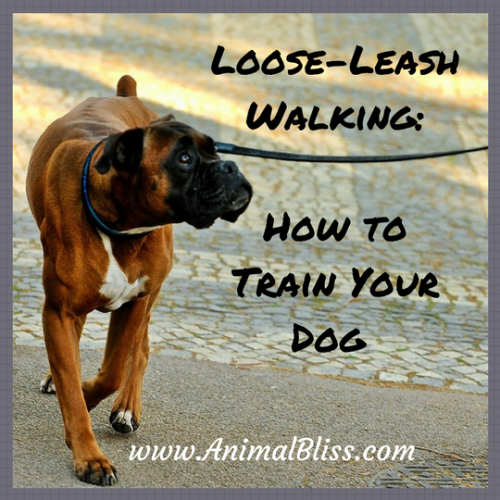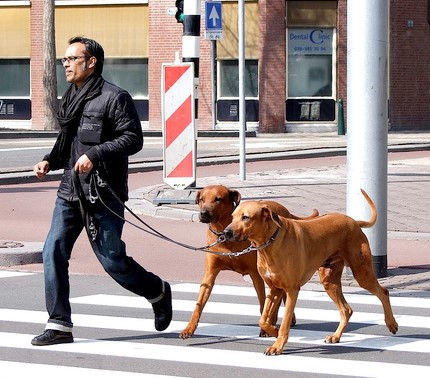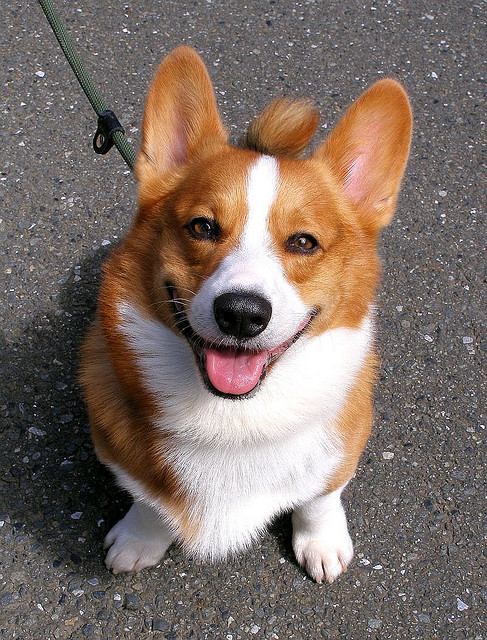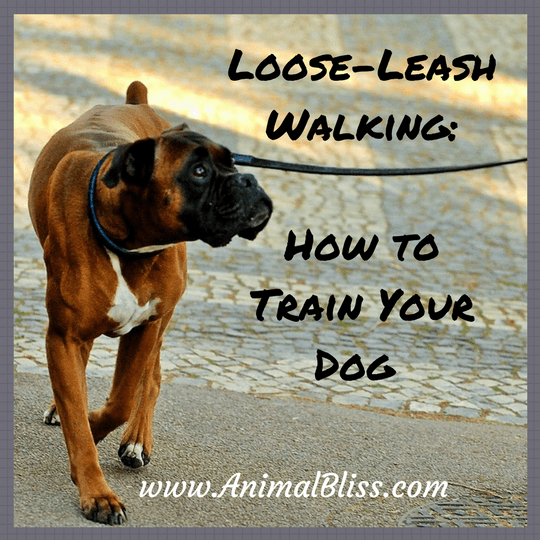Loose-Leash Walking Tips
Loose-leash walking is not to be confused with the “heel” command. Loose-leash walking is just good manners. You control the length of the leash, with your hand in a natural position alongside your body. As soon as the dog gets too far ahead or behind you, there will be tension on the leash, moving your hand out of its natural position; this is what we want to prevent. So the goal is that you, as the pack leader, set the pace and the length of the leash, and your dog peacefully walks with you, not interrupting your pace with frequent sniff breaks, or pulling ahead of you creating leash tension, and sometimes emotional stress!

Start practicing loose-leash walking in a distraction-free area, like the living room. As your dog masters loose-leash walking in this area, introduce her to other areas of increasing distractions, like the back yard, then a quiet street, then a busy street, etc. Make sure she is consistently walking loose-leash before introducing her to the next level of distractions, which might take a few days, but the patience is worth it. Eventually, with practice, your dog should be able to walk loose-leashed past even her biggest triggers. For my dog, it’s cats.
Related: Training a New Dog: How Can the Kids Help?
Start walking with your dog beside you. As soon as your hand moves due to tension on the leash, introduce a leash pop, which is just a swift, flick of your wrist. The severity of the leash pop depends on the dog. It shouldn’t be violent, especially for a small or skittish dog. On the other hand, larger or more stubborn dogs might not respond to very soft leash pops, so start soft, and gradually increase the severity of the leash pop until they react and the leash loosens. It doesn’t need to be any more severe than that so training doesn’t become an unpleasant experience for your dog.

As you walk, remember: you choose the pace. Don’t stop every time your dog. Corrections (leash pops) should happen in motion, without you having to break your stride.
When loose-leash walking your dog, remember -- you and you alone set the pace. Click To TweetYou want to set the pace as the pack leader. So if your dog consistently pulls ahead, you can turn around and start walking in the opposite direction. She will probably adapt quickly and start pulling in this new direction, so just keep turning around unexpectedly until she understands that she isn’t going to get where she wants to go. This technique isn’t the first choice for fearful or skittish dogs since the abrupt change in direction might startle or scare them. But these dogs usually aren’t the worst pullers either. 🙂
Remember that timing is everything. For corrections, you must pay close attention and administer the leash pop immediately after your dog goes too far.

You can add a verbal correction for a very distracted dog, but loose-leash walking is just about good manners for your dog. It shouldn’t be a response to a verbal command, but rather should be expected at all times. A verbal correction, like “No” isn’t a command, it’s only to be used when she is very distracted.
So there you have it! We love this method because it doesn’t rely on treats or clickers, which you may not have on hand when you want to go for a walk with your dog. Achieving loose-leash walking takes practice and consistency. Only work with one dog at a time, since they are distractions to each other, and keep the training sessions short, like 5-10 minutes at a time. Practice with your dog multiple times per day, every day. Give her time to decompress and relax after each training session, and be aware if she is showing signs of stress.
Dog walking becomes a dream when you and your dog master loose-leash walking. Good luck!
~~~~~~
AUTHOR: If you are looking for San Diego dog training services, you may visit Doggiejoggie.com
Loose-Leash Walking Tips: How to train your dog to walk alongside you, with no tension, at your own pace. #dogs #dogTraining Click To Tweet![]()
MY QUESTION FOR YOU:
Have you ever had the experience of your dog having a litter of puppies? Was it exciting?
*** Leave your comment below. ***
(It’s just sexy!)

Thank you for taking the time to visit my blog!

*
DISCLOSURE: Animal Bliss is a participant in the Amazon Services LLC Associates Program, an affiliate advertising program designed to provide a means for us to earn fees by linking to Amazon.com and affiliated sites.
(In other words, we’ll get a very small, teeny tiny) commission from purchases made through links on this website.)
(Coffee money – thank you!)
😛
[amazon_link asins=’0761168850,1607748916,1592533256,B01DN07JUM,B01KG9WMWI’ template=’ProductCarousel’ store=’animalbliss-blog-20′ marketplace=’US’ link_id=’bd9f140a-6ff1-11e7-b6b3-21d52b4f1d30′]
😀
- 4 Tips for Maintaining Healthy Weight for Your Cat - December 20, 2019
- 8 Amazing Benefits of CBD for Dogs and Other Pets - December 12, 2019
- Kibble or Canned Pet Food? What Should Your Pet Be Eating? - December 9, 2019


I really appreciate this information on how to walk your dog properly. I like the idea you give of practicing loose-leash walking to give the dog more freedom, but to also maintain control. I bet professional dog walkers are great at this and know how to help dogs have the best experiences while they’re out on walks!
Thanks for taking the time to visit my blog, June. A appreciate your comment too. 🙂 Come back soon.
We had a 105 pound black lab growing up. He had a heart of gold, but sometimes he didn’t know how much bigger he was an other dogs. Sadly, he got easily distracted on walks, and some cities have strict leash laws. It’s best if you know your dog and how to handle him to avoid any emergency visits to the vet.
Wow! That was a big black lab! Yes, it’s important to know your dog and what’s required while walking him in order to keep yourself, others, and your dog, safe. Thanks for stopping by.
Loose leash walking is an ongoing issue with Rico because the little bugger thinks he is my pack leader. It’s the Chihuahua in him (see even hard to spell let alone walk 🙂 Thanks Jeanne!!
Oh, yes. I know the type. The dog walks you, right? lol Thanks for your comment, Rory! Come back soon.
We recently purchased a Gentle Leader for Bentley (our Basset) and it works well. We can actually loose leash walk.
That’s great! Gentle Leaders are a wonderful tool. 🙂
Very interesting. It is really important to make sure that you have good control of a pet if you are going to take it outdoors with you. I’m not sure if I’ve ever hear of this technique before. Of course, I haven’t owned a dog in more than 10 years.
I’ve used this method with my rambunctious German Shepherd. It really worked very well for her. Before that, she almost pulled me out in from of an oncoming semi truck. Oof! 🙂 Thanks for your visit, Robin.
Hi! This is great infomation…But I have a question…I have 2 female Shepinoise (German Shepherd-Belgin malinoise) police pups. The problem is they do not have a slow pay attention speed. They are 5 months old and have been stuck in high gear since 8wks old. How do I have a chance to be in charge when the whole time I am trying to get them to sit long enough to be rewarded for it? They are just big ole bundles of PLAY! and I am ready to try to walk them on the leash properly.
Great tips! Love the corgi picture
Thanks, Rachel. Yes, I love the Corgi pic too. He’s adorable. 😉
It must be lots of fun to be walking with a dog and the easiest way to train him is for him to walk with you. It is no different than jogging along with someone. If you go to fast you lose him, if you are too slow he runs ahead of you. Pace yourself and walk with da dog. That way you are taking care of each other.
Lawrence Bergfeld
Yes, it’s lots of fun to be walking with your dog, Lawrence. There’s just nothing like it. 🙂
We used to follow this technique, it is one used by Cesar Millan “Dog Whisperer”. But we quickly discovered it really isn’t the best way to teach loose leash walking and abandoned it because it turned the walk into a punishing activity rather than a bonding experience. “Leash pops”, collar jerks, yanking on the dog, etc.. are actually a part of “positive punishment” in the dog training world. What this means is that you are teaching a dog that their behavior causes a bad thing to happen – the goal being that the behavior will decrease which is not true in all cases. Prong collars and electric shock collars all fall into this category.
Leash pops can induce anxiety in sensitive dogs, can cause flinching, and humans being generally not very patient can become frustrated and in turn “correct” harder and harder if the dog doesn’t “get it”.
Positive training on the other hand teaches loose leash walking through rewarding the dog for the proper position, and stopping or doing a U-turn when the dog moves too far ahead or begins to pull, but then immediately rewarding again for proper positioning. The dog in turn learns that if they want to go forward they must be beside you. This is “positive reinforcement” – dogs behavior causes a good thing to happen, and “negative punishment” – dogs behavior causes a good thing to stop.
If you use treats initially you are also rewarding the dog for paying attention to you and “checking in” or giving you eye contact. The treats are then easily phased out for a perfect walk, but like all things must be practiced regularly.
Scientific research and veterinary studies have shown that dogs trained through positive training techniques learn quicker, they respond faster, and the results last much longer.
Thank you for the lengthy response, DZ Dogs. It’s an eye-opener, and definitely something to consider. It seems that dog obedience training methods and philosophies have changed and evolved over the years. The days of prong collars and shock collars are phasing out, I hope? I wonder if different methods work better for different dogs? As you mention, for sensitive dogs, the pop method might cause them undue stress. But I think for larger dogs, it might not effect them as much. I’ve trained my German Shepherds using the pop method in the past and they seemed to turn out fine. Best dogs I’ve ever had. It may have been different had they been little Yorkies or something small like that. I do share your concern about humans that may lose patience and correct harder and harder. I’ve seen that happen in fact. It’s not all black and white, I’m afraid. I very much appreciate your outlook and respect your method of dog training and love that you took the time to read this article. Peace
I need a post on cat walking 😀
Do you? I’m sure your cat, from what I’ve read, is too sophisticated for that nonsense. She/he (I’m sorry, I can’t remember the gender) seems perfectly happy to walk around the apartment and wouldn’t dirty her royal feet on those lowly streets. 🙂
Yes historically this is true hahaha. Maybe if I could get a harness and leash on him he’d be more agreeable.
Alas, I’m afraid you would lose some skin and blood. Mostly blood.
Great tips here… except sometimes those little poochies refuse to behave…:)
Oh, don’t I know it. I had a German Shepherd that seemed impossible for such a long time, but she eventually “got it” and all was well and we lived happily ever after. 😉